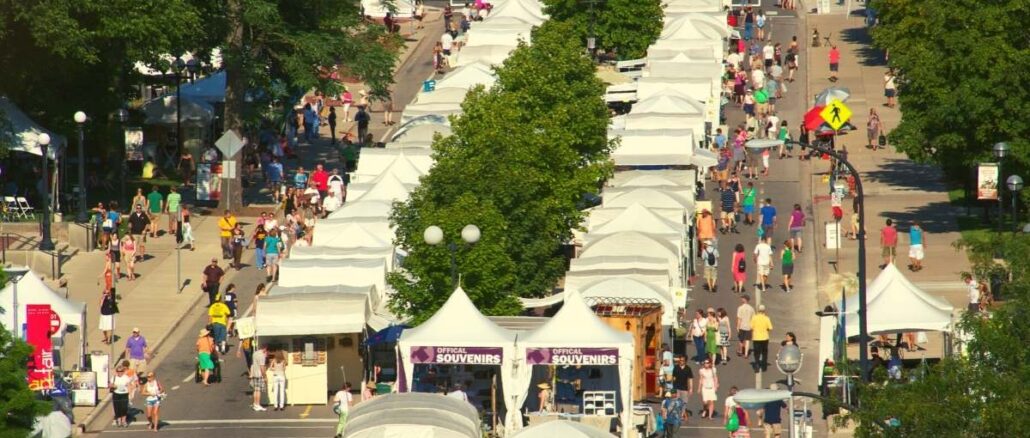
Here are tips and observations from selling show space and attending fine art consumer and trade shows for decades. My knowledge comes from participating in fine art, home furnishing, interior design showrooms, and marts in the day. Like many artists, vendors, and exhibitors, I miss the glory days of ArtExpo New York in the Jacob Javits Center, the Decor Expo Atlanta in the Georgia World Congress Center, and the High Point Market and regional home furniture shows and design centers.
Every artist should live by these words: Never feel bad about successfully selling your creations. Never feel bad about creating art you can’t sell.
— Marc Ecko
In Part One, We Cover These How to Sell Art at Shows Topics:
- Booth Appearance.
- Inventory Management.
- Cohesiveness and Clarity.
- Booth White Space.
- Your Appearance.
- Your Attitude.
While I have exhibited at many shows, I primarily attended to mix and mingle with all my customers and as many other industry figures as I could encounter. At a typical show, I would visit the booths and showrooms of hundreds of exhibitors at a three-day show. That’s a lot of shoe leather, talking, and observing. So I did my best to take it all in and learn everything I could.
Today, I pass along collected wisdom, practical advice, and observations from decades of experience. I’ve put together a mix of suggestions, no-nos, and opinions that are certain to help you succeed in selling art at shows. Although some of this advice may seem rudimentary, I include it nevertheless because I too often encountered examples of exhibitors doing things contrary to common sense.
Booth Appearance.
Some shows give you pipe and drape, and you can rent walls. Others give you hard walls as part of the booth. Whatever you get, you have to make the best of it to make the best look to help you sell art at shows.
Make Your Booth Space Visually Appealing and Welcoming.
You have just a few seconds to give an impression of your work and yourself. Your booth needs to look like you care about your work, and you came to do business and take the opportunity to be there seriously. That doesn’t mean you can’t have a fun time and be jovial. Just make sure your booth looks as professional as it can.
The best thing you can do for many is set up the booth in advance at home, give it the white glove look and make improvements to kick it up a notch or two.
Inventory Management.
The amount of stuff you have in your booth is critical. How many times have you seen a booth that looks like a poorly run flea market? You know, the kind that has stuff crammed into every space. You cannot impress potential buyers this way. If you wonder why you are not getting the best price for your work and this in any way resembles how you set up your booth, you have a partial answer.
The reverse problem is the booth looks empty. That begs the question of what’s going on here? Unless it is the last hours of a successful show and clearing inventory to avoid shipping it home, you want your booth to be well-stocked and organized. Give thought to how you present your work. Is there a flow to what the viewer is seeing? Or, are they finding a jumble of things that make it hard for them to connect with your work?
Become Your Buyer to See and Feel Their Experience
You have to keep thinking about your buyers. Put yourself in their shoes. They know nothing about you and are being bombarded with sensory overload. They see so much work in one place. All kinds of people wandering around. Often entertainment and music playing. You are attempting to break through the noise and clutter they are experiencing. Finding an eye-pleasing, well-organized space is almost like a respite from the chaos around them. Think of your booth as a resort. Make it an inviting place for shoppers.
Your ambiance will, of course, vary with the type of art you have, who you are, and what vibe you want to give. Selling serene landscapes is one environment; selling images of hot chicks on hot motorcycles is another. Cater to your crowd, but keep it classy and organized no matter the motif and message you are sending.
Cohesiveness & Clarity.
You may have the talent and interest to create art in many genres. While a blessing for the creative you, it is not a way to sell art at shows.
You went to the great expense of buying the booth space, creating the art to fill it, preparing for and traveling to the show, and more. Please don’t blow it by setting a booth that looks like 12 different people made the art. Instead, settle in on your best images within a genre and mine that mother lode. Of course, you can always come back another time or go to another show and display that polar opposite side of your creativity.
A word of caution here. I would sometimes sell ad space or show space to an artist or publisher, and when I first got to see their work, I was astounded. It was not why you might think. It was because all the work looked similar. I know I just told you to have cohesiveness and clarity. That does not mean loading your booth with 100 originals of the same subject or in the same palette.
White Space.
In graphic design, white or negative space is critical. I mentioned how clutter is a show killer, and there is a lack of a booth. One of the worst things you can do is put a table in the front of your booth. NEVER do that. It sends a strong visual message that you attempt to create a barrier between you and the buyer.
You want an inviting environment as much as possible. Blocking the entry is a terrible idea. I realize a delicate balance between having enough product to display and keeping the amount of negative space to an appealing amount. I would tend to push it towards more space. Just a tad more than making you comfortable is likely to have the opposite effect on potential buyers.
These are generalities because art sizes are all over the place, from tiny pieces of jewelry to massive pieces of chainsawed sculpture and everything in between. If you keep the perspective of your visitor’s enjoyment and visual pleasure, you will make the right decision more often.
Your Appearance.
How you look affects your potential buyer’s assessment of you and your art. It also affects your self-confidence and esteem. You want to look professional. It tells the buyer that you care about yourself and your art. You don’t have to dress to the nines. Some shows are outdoors, from hot and dry to wet and cold. You should be wearing attire appropriate for the venue. It should be comfortable to help you stay in the moment during those long show hours.
What you are wearing should be fresh, not wrinkled, old, or tattered. It’s all part of the same thing: the booth visitor experience. Within a few brief seconds, they are already making assumptions about you, your booth, and your art: your clothing and personal appearance art part of that quick assessment.
Be You But Be the Best You.
Besides wearing appropriate attire, you should make sure your appearance is as good as it can be. Your hair is neatly combed or brushed. You don’t have food sticking in your teeth. The whole idea is to look successful. Confidence begets confidence. People naturally gravitate to those who appear successful and confident. Whether you feel internal like you are convinced is not the issue. It is about outwardly portraying confidence. Just showing high confidence helps you sell more art.
Your Attitude.
Have you become bitter, cynical, or lazy about putting out the effort to sell art at shows? Don’t feel alone; there are many people just like you. If this is you, and you know if it is, you have to face that your attitude feeds a vicious cycle.
I can tell you countless times when I saw someone in a booth, usually in the far corner or even behind the booth in a personal space, acting bored out of their skulls. Wow! That encouraged me to want to engage them. I would often come in with a chipper, cheerful attitude, hoping some of it would wear off on them. Sadly, it often had the opposite effect of making the sullen more sullen.
Sort Out the Real from Perceived and Work on It.
If your dog just died or your spouse ran off with your best friend, you have a legitimate reason for your gloomy outlook. Short of some personal disaster, you owe it to yourself to shake off the lousy ‘tude and get with the program. Please put it in perspective. You are only there at the show for a few hours out of your life. You have made a significant investment in time, money, product, and effort to be there. Take some deep breaths. Listen to some happy music. I don’t know about you, but I can’t help but feel sunny and optimistic when listening to Blue Sky by The Allman Brothers.
While you may not have control over the circumstances that have put you in a foul mood, you have complete control over how you choose to react to those circumstances. Your mind over matter power is off the charts. Learning how to put your negative feelings in check and work towards presenting a confident, if not happy, demeanor makes your art shine. It makes you more attractive. It will sell more art.
A quick note on buying booth space:
Your organizer works hard to put on a show and hopefully earns your respect. I appreciate show management is a hard job to keep everybody happy. In these pandemic days, everything is different. So, what I’m going to tell you is something I trust you will use with good intentions. My motto for negotiations is to be informed, tough, and fair.
Booth space is nearly always negotiable. Unless the promoter has a killer sold-out show, they have wiggle room. Whether it is on the booth costs, associated costs such as drayage, electrical, booth location, or promotional extras, you should work to make sure you get the best deal for yourself. You can drive a hard bargain without being a jerk. Learn to be pleasantly persistent because the squeaky wheel gets the grease and if you don’t ask, you don’t get.
But Wait, There’s More.
I’ve got many more tips on how to sell art at shows for you. So, please be on the lookout for next week’s post. You can hit the subscribe button on the top right to ensure you get it. All the best!







Be the first to comment